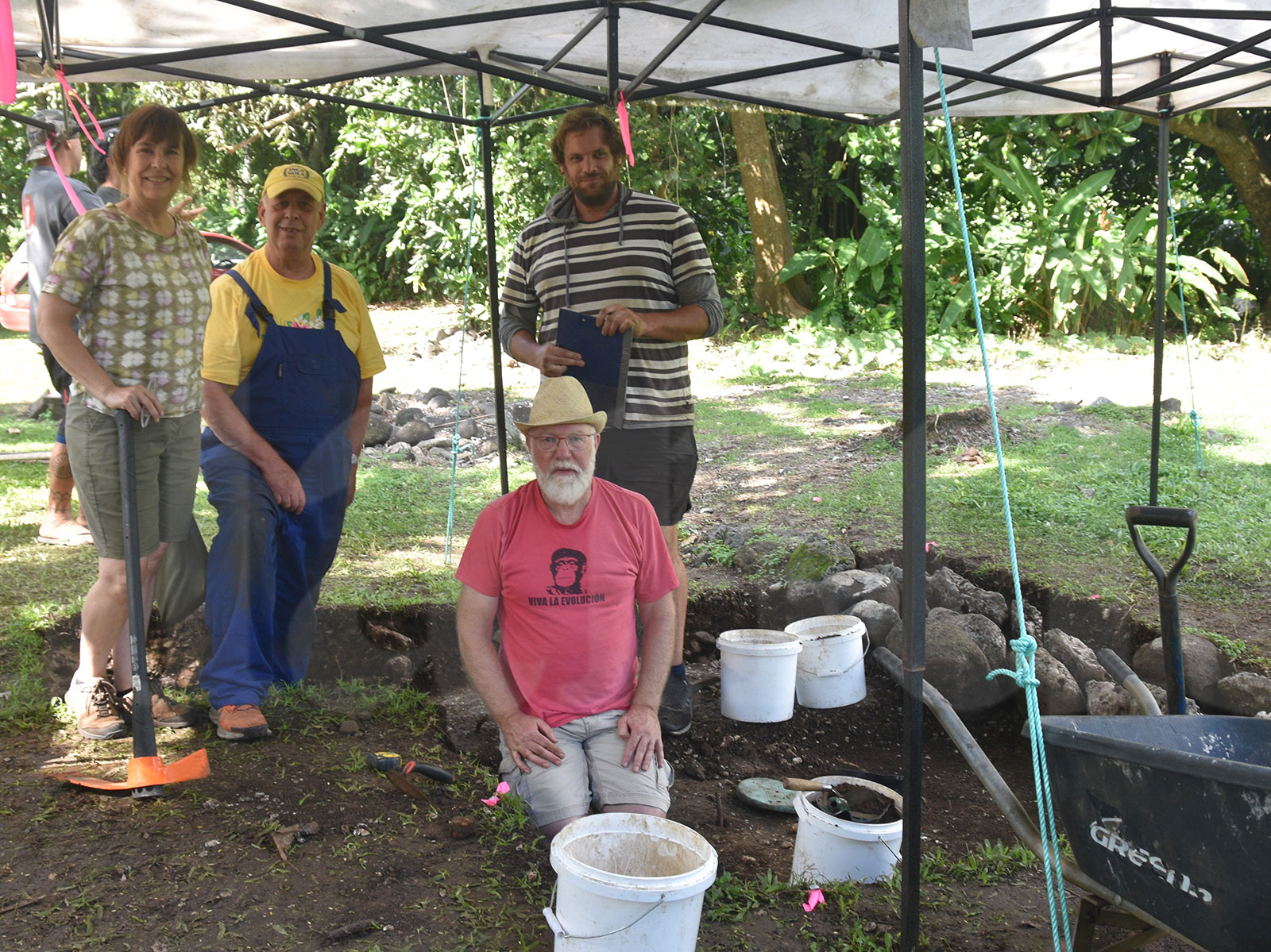Archaeologists unearth rich heritage
Thursday 22 June 2023 | Written by Melina Etches | Published in Art, Culture, Features, Local, National

Professor Jane Downes (University of Highlands & Islands, UK), Professor Colin Richards (University of Highlands & Islands, UK), Brendan Kneebone and Dr Matthew Campbell. MELINA ETCHES/23062105
Archaeologists visiting the Cook Islands have uncovered a formation of rocks at the Arai-Te-Tonga marae at Tupapa.
This indicates that Arai-Te-Tonga in some form was here before the ara metua (original inland road) was formalised as a coral road, said Professor Colin Richards of the University of Highlands & Islands, UK.
“Almost certainly before the road would have been a path, but we can’t see that. What we have done is we have found the sequence and my guess is we’re looking at something like between the years 1300-1400,” he said.
Archaeologists can shed light on the past, contributing to a deeper understanding of the islands identity.
The archaeology team of Professor Jane Downes (University of Highlands & Islands, UK), Professor Colin Richards (University of Highlands & Islands, UK) and Professor Kate Welham (Bournemouth University, UK) are here to see, how does the ara metua relate to Arai-Te-Tonga.
The team’s recent discovery was black basalt that goes with the later paving of the ara metua. The coral rock facing is found deeper in the ground.
The trench was dug to work out the basalt and the coral to see what it looked like.
“It’s been really good and really successful,” said Professor Richards.
“We are digging down to get more samples.
“When you excavate, there’s always something else you want to see.”
The archaeologists have discovered two post holes.
“What this tells us is there was a lot going on in front of it, it’s all building up a picture of what it was like, how it related to the road here.”
Prior to Rarotonga, the archaeologists had worked in Rapa Nui (2006- 2014) and one of things that they became interested in there was the roads called Moai Roads.
The roads on Rapa Nui all started at one place and ended at another, said Professor Richards.
“When you have a circuit road like Rarotonga, there is no beginning and no end, and that was interesting for us because what starts and stops a journey is you getting onto the road and you getting off again…”
Through their research the visiting team could find out how the road changed along its route, he said.
“In Rapa Nui when the road passed important places it became more embellished; maybe a little bit like here.”
The archaeological work at Arai-Te-Tonga started in 2018 with a geophysical survey.
“We came here (in 2018) only to discover that the ara metua is under asphalt, under the metal surface of the road.”
The team contacted Infrastructure Cook Islands (ICI) and talked to their engineers.
“They were brilliant and really helpful like Tenga and they were interested in what we were doing.”
That year they discovered a stretch of the ara metua here which wasn’t buried.
In 2018, the first trench revealed at least three different roads. The fairly recent road dating to the 1950s was surface with black basalt cobbles and was quite wide and below that was a much narrower, beautiful coral road estimated to be from 1800s. The earliest road was a level spread with kirikiri coral pebbles that was completely flat.
Interested to see what was underneath the road, the team dug deeper and directly under the road they found a pig that had been buried, “which is wonderful for us because we could get radiocarbon dates”.
Professor Richards added that the pig had not been cut up to eat.
Using radiocarbon dating, they discovered that the pig had died around 1450.
The charcoal in the soil was also tested and it indicated a date between 1450 and 1550.
Lots of other things were also found in the soil including pollen, yam, banana, sugarcane and candle nut.
In 2019, the archaeologists returned to continue with their work
The archaeologists came to Rarotonga from Niue, and had spent two weeks in Atiu.
“We would like to say thank you to all the people who supported us, the landowners and they’re just as interested as we are and everybody has been so helpful, thank you for allowing us to be here.”
Tonight, the archaeologists will be holding a public lecture at the USP Cook Islands Campus at 5pm. Everyone is welcome to attend.
Dr Matthew Campbell, who completed a thesis in 2001 on “Settlement and landscape in late prehistoric Rarotonga, Southern Cook Islands”, is also part of the team.




































